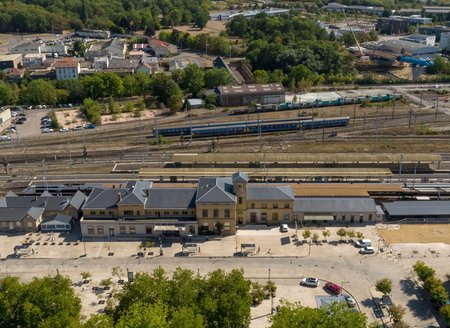- Handicap mental
- Handicap moteur
- Handicap auditif
- Handicap visuel
Gare

L’installation du chemin de fer à Thionville remonte au milieu du XIXe siècle. Une première gare est construite sur la rive gauche de la Moselle, à environ 800 mètres des remparts de la ville, dans le faubourg de Beauregard. La particularité de cette station était d’être positionnée en impasse, terminus de la ligne Metz-Thionville. Lors de la création de la ligne Thionville-Luxembourg en 1859, elle devient une gare de passage.
Après l’Annexion de 1871, les Allemands décident la création d’une nouvelle gare rive droite, ou plutôt sur une ile entre Moselle et canal, construite entre 1875 et 1878. Les motivations germaniques étaient de deux sortes : stratégiques tout d’abord, le chemin de fer servant au transport de troupes en cas de danger et urbanistiques ensuite, l’essor du faubourg de Beauregard attirant vers lui un grand nombre d’industries.
En 1896, la gare de Thionville compte 5 postes d’aiguillage en service ; en 1917, on assiste au quadruplement de la ligne Thionville-Metz. La gare emploie en 1912 près de 1200 cheminots, soit plus d’ouvriers et d’employés que l’industrie à l’époque. En 1913, on comptabilisait quotidiennement le passage d’environ 294 trains de marchandises. A la Libération, ce chiffre oscille entre 240 et 280 trains qui transitent par la gare de Thionville. Celle-ci emploie alors 440 à 450 employés et plus de 250 agents de train, en comptant les ateliers de Basse-Yutz.
Durant la Grande Guerre la gare de Thionville sera régulièrement bombardée provoquant pertes humaines et gros dégâts matériels.

RAILWAY STATION
The railway station dates back to the middle of the 19th century. A first station was built on the left bank of the Moselle, about 800 meters from the ramparts of the city, in the suburb of Beauregard. The distinctive feature of this station lies in the fact it was a dead end, and the end of the Metz-Thionville line. When the Thionville-Luxembourg line opened in 1859, it became a transit station.
After 1871, the Germans decided to build a new station on the right bank, or rather on an island between the river Moselle and the canal, built between 1875 and 1878. The German motivations were of two kinds: strategic first, with the railroad being used to transport troops in case of danger, and then urban, with the development of the suburb of Beauregard attracting a large number of industries.
In 1896, Thionville station had 5 signal boxes in service; in 1917, the Thionville-Metz line increased fourfold. In 1912, the station employed nearly 1,200 railway workers, more workers and employees than the industry at the time. In 1913, there was a daily count of approximately 294 freight trains. At the time of the Liberation, this figure ranged between 240 and 280 trains passing through Thionville station.
During the Great War, Thionville station was regularly bombed, causing loss of lives and considerable damage.

DER BAHNHOF
Die Einrichtung der Eisenbahnlinie in Thionville reicht in die Mitte des 19. Jahrhunderts zurück. Ein erster Bahnhof wurde am linken Moselufer im Vorort Beauregard gebaut, etwa 800 Meter von der Stadtmauer entfernt. Der Bahnhof war als Kopfbahnhof konzipiert und war Endstation der Eisenbahnlinie Metz – Thionville. Beim Bau der Linie Thionville – Luxemburg 1859 wurde der Bahnhof zu einem Durchgangsbahnhof.
Nach der Annexion 1871 beschlossen die Deutschen den Bau eines neuen Bahnhofs am rechten Moselufer oder genauer auf einer Insel zwischen der Mosel und dem Kanal, der von 1875-1878 entstanden ist.Es gab zwei Beweggründe für diese Entscheidung: Aus strategischen Erwägungendiente der Bahnhof zum Truppentransport, wenn Gefahr drohte. Aus stadtplanerischer Sicht war der Bahnhof wichtig, da der wirtschaftliche Aufschwung im Vorort Beauregard viele Industrieansiedlungen begünstigte.
1896 hatte der Bahnhof von Thionville fünf Stellwerke in Betrieb. 1917 vervierfachte sich der Betrieb auf der Linie Thionville-Metz. 1912 arbeiteten etwa 1200 Eisenbahner am Bahnhof, es gab dort in dieser Zeit also mehr Arbeiter und Angestellte als in der Industrie. 1913 zählte man täglich ca. 294 Güterzüge, die den Bahnhof passierten.
Bei der Befreiung bewegte sich diese Zahl zwischen 240 und 280 Zügen. Der Bahnhof hatte damals zwischen 440 und 450 Angestellte sowie mehr als 250 Zugbegleiter, wenn man die Werkstätten in Basse-Yutz mitzählt.
Gare
15 chemin des Bains


























